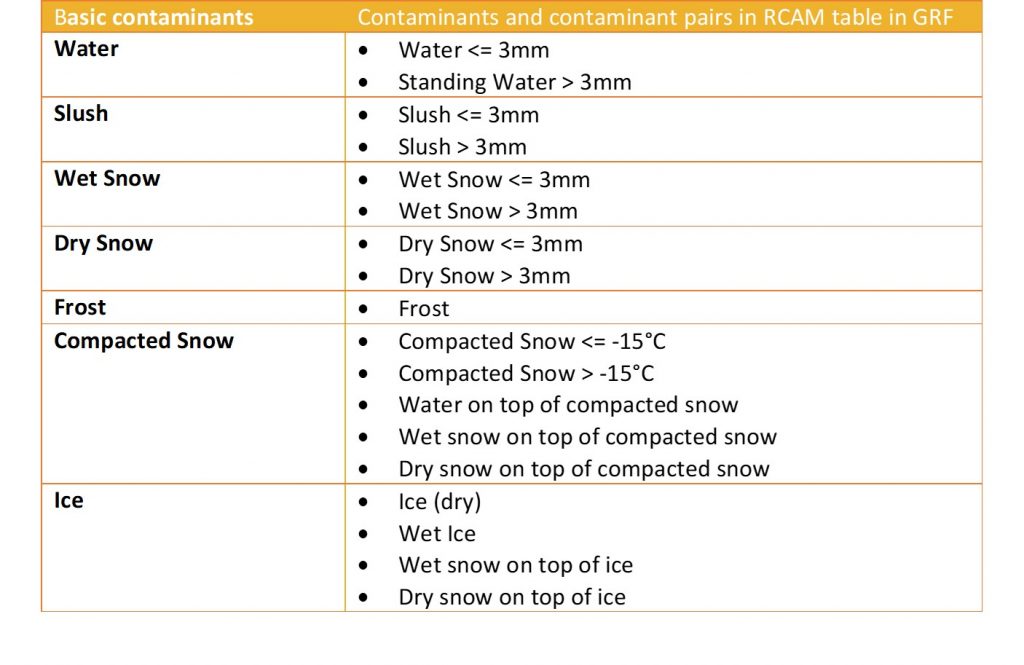In the previous posts, we explained different aspects of Global Reporting Format (GRF) regulations and the changes in respect to runway inspectors’ work. In practice, the transition to GRF regulation might create some confrontations that need to be considered carefully. In this post, we compare the old type of runway reporting and GRF runway conditions reporting and present you some key confrontations in respect to runway inspectors, pilots, and airports’ works and possible reconciliations to solve these problems.
1. Runway inspector’s problem — increased types of contaminants
The main challenge in a runway inspector’s work is that instead of observing seven familiar basic types of contaminant, they should observe 18 different contaminants or contaminant pairs. The below table illustrates this change. As it is shown in the table, the old basic types of contaminants include: Water, slush, wet snow, dry snow, frost, compacted snow, and ice. New contaminants or pair of contaminants that have been defined in the RCAM table in GRF regulations are built up from these basic contaminants, however, considering depth, temperature, or the combination of these two on top of something (e.g. compacted snow or ice).

The easier and safer practice for the inspector is to observe seven basic contaminants recognized by the airplane performance when assessing and observing each runway third. From these basic contaminants, a RCAM contaminant for that specific runway third can be derived, and that RCAM contaminant will be published in the SNOWTAM.
2. Runway inspector’s problem —report landing or take-off critical contaminants
Another confrontation in the runway inspectors’ work is that when the runway inspector observes the runway or runway third, should the inspector report landing critical contaminant or take-off critical contaminant? In this context, landing and take-off refer to the aircraft performance and performance calculation.
Reconciliation:
RCAM table was originally designed to support runway condition assessment from landing performance point of view. That is why RWYCC-value plays a major role in the assessment. However, RWYCC-value has no role in take-off performance. To safely cover both take-off and landing, the runway inspector should choose the RCAM contaminant having the greatest impact on take-off performance and RWYCC-value having the correct effect on landing performance. To safely cover take-off and landing, in certain runway conditions may require reporting, where RCAM contaminant type and its respective (nominal) RWYCC-value cannot be “locked” and a RWYCC downgrade procedure should be applied. For further information, read our previous blog on How to Report Runway Conditions to Satisfy Both: Take-off and Landing.
3. Airports problem
Another confrontation is related to the airport policy. The question is that should the airports use friction tester as an input when assessing runway conditions or should they use only subjective inputs? This is more or less a policy question and the decision should be made by the airport and not directly by the inspectors.
Reconciliation:
We believe and encourage the use of runway friction tester as one assessment tool when assessing runway conditions. Friction values are a valuable piece of information especially when assessing runway condition code upgrade or downgrade as well as assessing slippery wet runway condition during summertime.
4. Pilot’s problem
Sometimes multiple basic contaminants are observed on the runway and the RCAM contaminant derived contain contaminant pairs. Moreover, these contaminant pairs may not be equal per runway third. According to RCAM and GRF, two basic contaminants on one runway third can be reported which means that, in the worst case, six different basic contaminants can be reported on the whole runway. However, the pilots are able to use only one basic contaminant type as a parameter for the take-off performance calculation or landing performance calculation in the flight planning phase. In flight, the pilots may calculate aircraft performance solely based on runway condition code.
Reconciliation:
It is easier and safer for the pilot if the results are analysed and a one take-off significant contaminant is issued in the SNOWTAM situational awareness section. For further information, read our previous blog on How Can Airport Support Cockpit Crew in Their Performance Calculation.
Global Runway Reporter (GRR) software:
GRR Mobile software handles efficiently the reporting process of runway conditions and automates the SNOWTAM publishing. When using GRRM, runway inspector can focus on the essential: observing and reporting the seven familiar “basic” contaminants. GRR application will calculate RCAM contaminants for runway thirds, and one single take-off significant contaminant (TOSC) representing the complete runway.
